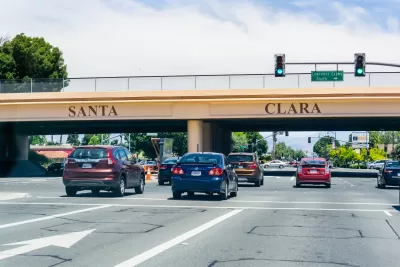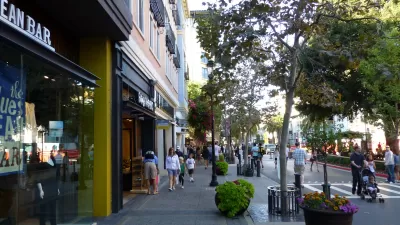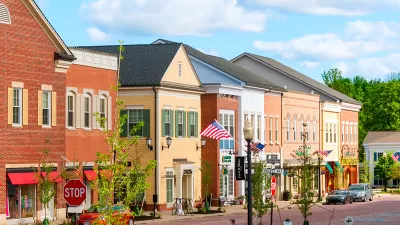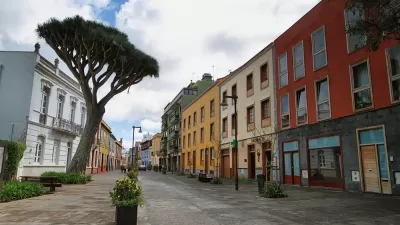The built environment in one of the most affluent places in the country leaves much to be desired. Why are Silicon Valley communities missing so many key urban features?

Picture Silicon Valley and you might imagine “techies doing cool tech things on every sidewalk, in every restaurant and juice bar, in every garage and loft, on every bus, train, scooter, and hoverboard.” But that’s far from the reality, writes Josh Stephens in Common Edge.
The real Silicon Valley is so dull, it makes you want to climb atop the nearest standing desk and hurl yourself off headfirst. It makes you want to put on VR goggles and never take them off.
For Stephens, Santa Clara, arguably the center of Silicon Valley, is “somehow, even more bleak” than its endless office parks, strip malls, and mid-density apartment complexes would imply. With an average home price of $1.5 million and rents at over $3,000 per month, Santa Clara is an unusual yet “ordinary example of 20th century urbanism.” A bigger question might be, “is Santa Clara’s bleakness a feature or a bug? Why do all of those wealthy people and wealthy companies want to live with all of that ugliness?”
The wealth in Santa Clara, unlike more ostentatious enclaves like, say, Beverly Hills, is hidden, Stephens writes, in part because if it was more apparent, maybe people would demand a more livable, affordable community. “Meanwhile, all over the Bay Area, young professionals sleep on sofas; public-sector workers commute in from beyond the horizon; people reside in boxes up in the Tenderloin; and low-income workers without cars live extralegally wherever they can.”
Stephens asserts that Santa Clara “warrants scrutiny for all that it has squandered,” using none of its immense wealth to create anything close to a vibrant city. “If the city harnessed even a fraction of the capital sloshing around its city limits, it could transform itself into a model of equity, sustainability, and creativity.”
Stephens concludes that “Santa Clara’s underperformance is not a moral failing exactly. Cities rise and fall collectively.” Santa Clara may offer a high-profile example of our failures, but it’s nevertheless part of a collective failure.
FULL STORY: Is Santa Clara—the Heart of Silicon Valley—Soulless and Banal by Intent?

Study: Maui’s Plan to Convert Vacation Rentals to Long-Term Housing Could Cause Nearly $1 Billion Economic Loss
The plan would reduce visitor accommodation by 25,% resulting in 1,900 jobs lost.

North Texas Transit Leaders Tout Benefits of TOD for Growing Region
At a summit focused on transit-oriented development, policymakers discussed how North Texas’ expanded light rail system can serve as a tool for economic growth.

Using Old Oil and Gas Wells for Green Energy Storage
Penn State researchers have found that repurposing abandoned oil and gas wells for geothermal-assisted compressed-air energy storage can boost efficiency, reduce environmental risks, and support clean energy and job transitions.

Private Donations Propel Early Restoration of Palisades Playground
Los Angeles has secured over $1.3 million in private funding to restore the Pacific Palisades playground months ahead of schedule, creating a modern, accessible space that supports community healing after recent wildfires.

From Blight to Benefit: Early Results From California’s Equitable Cleanup Program
The Equitable Community Revitalization Grant (ECRG) program is reshaping brownfield redevelopment by prioritizing projects in low-income and environmental justice communities, emphasizing equity, transparency, and community benefits.

Planting Relief: Tackling Las Vegas Heat One Tree at a Time
Nevada Plants, a Las Vegas-based nonprofit, is combating the city’s extreme urban heat by giving away trees to residents in underserved neighborhoods, promoting shade, sustainability, and community health.
Urban Design for Planners 1: Software Tools
This six-course series explores essential urban design concepts using open source software and equips planners with the tools they need to participate fully in the urban design process.
Planning for Universal Design
Learn the tools for implementing Universal Design in planning regulations.
Ascent Environmental
Borough of Carlisle
Institute for Housing and Urban Development Studies (IHS)
City of Grandview
Harvard GSD Executive Education
Toledo-Lucas County Plan Commissions
Salt Lake City
NYU Wagner Graduate School of Public Service





























